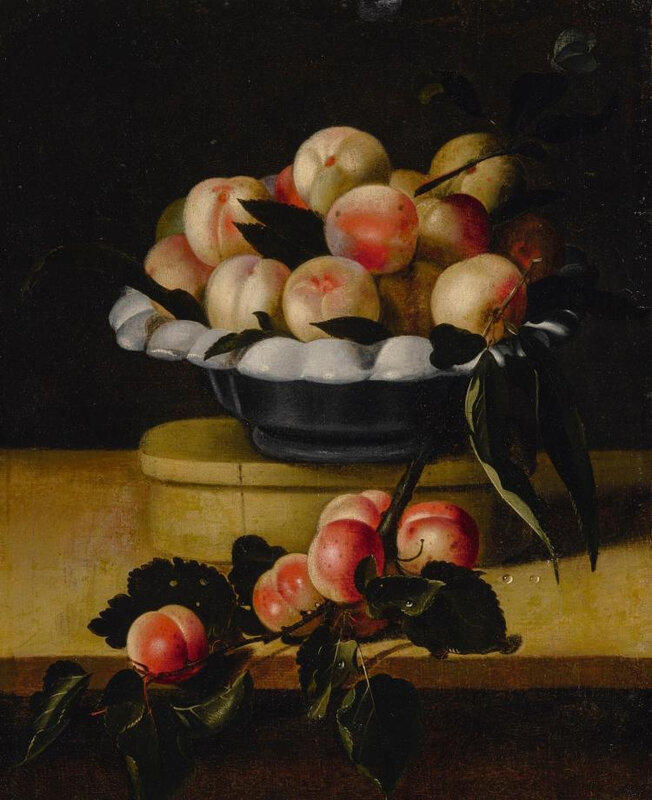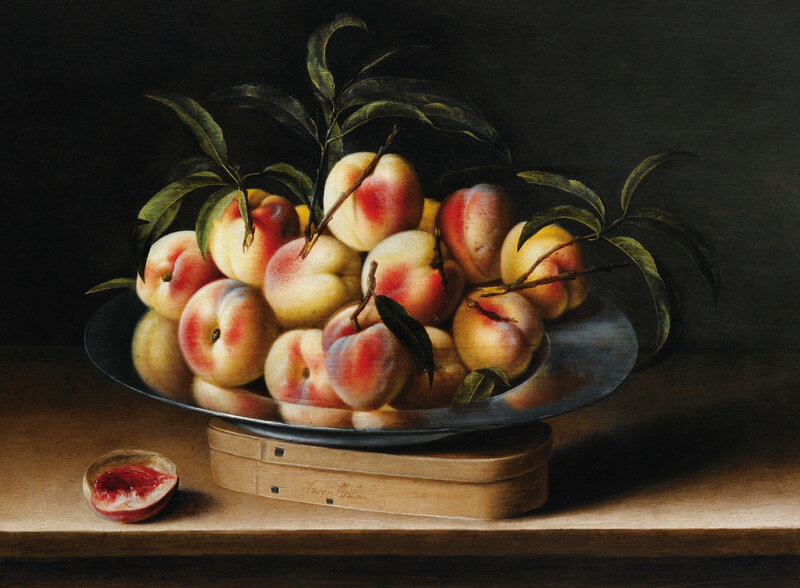Sotheby's. Master Paintings, New York, 22 May 2018, 02:00 PM
Louise Moillon, Still life of a peaches in a bowl standing on a wooden box on a ledge, an apricot branch resting in the foregrou
Lot 49. Louise Moillon (Paris 1610 - 1696), Still life of a peaches in a bowl standing on a wooden box on a ledge, an apricot branch resting in the foreground, oil on canvas, 21 5/8 by 17 3/4 in.; 55 by 45 cm. Estimate 150,000 — 200,000 USD. Lot sold 275,000 USD. Courtesy Sotheby's.
Provenance: Art market, Paris;
There acquired by the present collector.
Exhibited: Turin, Fondazione Accorsi, L'incantesimo dei sensi: una collezione di nature morte del Seicento per il Museo Accorsi, 30 November 2005 - 1 May 2006, no. 19.
Literature: A. Cottino, L'Incantesimo dei sensi: Una collezione di nature morte del Seicento per il Museo Accorsi, exhibition catalogue, Turin 2005, pp. 80-81, 111, cat. no. 19, reproduced p. 81;
D. Alsina, Louyse Moillon (Paris, vers 1610-1696), La nature morte au Grand Siècle, Dijon 2009, p. 201, cat. no. 66, reproduced.
Note: Louise Moillon was one of the very few female painters in seventeenth century France whose work and name have been consistently held in high regard. Only about 75 paintings by Moillon are known, almost all pure still lifes, though some incorporate figures. Moillon's paintings are indebted to one of the pioneers of still life painting and fellow female artist Fede Galizia (c. 1574-1630), whose signed and dated still life of 1607 is one of the earliest Italian paintings in the genre that can be securely dated.1
Most of her paintings date to the 1630s, and after her marriage in 1640 to the wealthy timber merchant Etienne Giardot de Chancourt she significantly slowed her production. This quiet, elegant painting of peaches was attributed to Louis Moillon in 1984 by Michel Faré, who dated the painting to 1632-4. More recently, Alsina (see Literature) argues that the work should be dated to after 1641, given the careful rendering of the compositional elements and the treatment of light.
Moillon often reused objects in her still lifes over the years. Moillon incorporated the small boîte en copeaux (wood-shavings box) in a few of her works, including a still life of plums in the Musée des Beaux-Arts Strasbourg (inv. 1689)2 and the still life of peaches formerly in the Grandchamps des Raux collection and sold in their sale at Sotheby's Paris, 26 March 2015, for 1,083,000 euros (fig. 1).3 The inclusion of this small wood shavings box, upon which the heavy porcelain dish is precariously balancing, is likely inspired by the work of Alsatian painter Sebastian Stoskopff, one of the great still life artists of the first half of the 17th century. Stoskopff lived in Paris from about 1622 to 1639, when it is likely that Moillon encountered his work. A similar porcelain bowl to the one in the present work can be found in a number of paintings by the artist, including her still life of cherries, now in the Louvre (inv. no. RF 1982-21).4
Louise Moillon, Nature morte de pêches sur un plat d'étain, boîte de copeau (Still life of peaches on a tin dish, chip box), 1634, oil on panel. 19.3 in.; 25.6 in. / 49 cm.; 65 cm. Sold for 1,083,000 EUR at Sotheby’s Paris, 26 March, 2015, lot 6.
1. A Crystal fruit stand with peaches, quinces and jasmine flowers, signed with monogram lower left: · FG · and dated lower right: 1607, oil on poplar panel, 31.2 by 42.5 cm. Sold London, Sotheby's, 8 July 2015, lot 29.
2. Oil on panel, signed and dated 1632, see Alsina, under Literature, cat. no. 14, pp. 130-131.
3. Now in a private collection. Signed and dated 1634, oil on panel, 49.5 by 64.5 cm.
4. Signed and dated 163[?[, oil on panel, 48 by 65 cm. See Alsina, under Literature, cat. no. 16, pp. 136-7.

/https%3A%2F%2Fprofilepics.canalblog.com%2Fprofilepics%2F1%2F0%2F100183.jpg)
/https%3A%2F%2Fstorage.canalblog.com%2F03%2F02%2F119589%2F96711876_o.jpg)
/https%3A%2F%2Fstorage.canalblog.com%2F11%2F31%2F119589%2F94773502_o.jpg)
/https%3A%2F%2Fstorage.canalblog.com%2F20%2F83%2F119589%2F94772815_o.jpg)
/https%3A%2F%2Fstorage.canalblog.com%2F26%2F72%2F119589%2F75604929_o.jpg)
/https%3A%2F%2Fstorage.canalblog.com%2F59%2F60%2F119589%2F26458628_o.jpg)




/image%2F1371349%2F20240312%2Fob_183045_431914962-1632264750876871-38629381506.jpg)
/image%2F1371349%2F20240311%2Fob_14e107_ed6d3066-e26f-4652-b29e-33e89de2fe09.jpg)
/image%2F1371349%2F20240311%2Fob_2b18d7_7c6f5ff1-5d4b-4485-8335-919ff9cd27e02.jpg)
/http%3A%2F%2Fwww.sothebys.com%2Fcontent%2Fdam%2Fsothebys-pages%2Fblogs%2FSlideshow%2F2018%2FApril%2F38-OMP-Caravaggio-still-life.jpg)